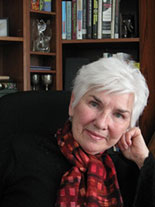Dr. Nancy Gibson
Learning to Listen: Community Based Participatory Research
CIET Canada (McGill) and University of Alberta

“I’ve learned that without the expertise of community partners— my research just doesn’t work. Fortunately I learned that a long time ago.”
A senior researcher at CIET Canada (McGill) and Professor Emeritus of the University of Alberta Dr. Gibson is a pioneer of community based participatory research (CBPR). She continues to work with Aboriginal communities in the Canadian North.
Two experiences in her past shaped her research methods: her work in Sierra Leone revealed the limitations of the academic model, and projects in Edmonton showed the importance of involving the community. “My work in Sierra Leone in 1996 was with traditional healers and my research goal was to figure out what they have in common, to help them to organise a national program. The answer from the research was, not much really,” says Dr. Gibson. “Clustering information and doing the time-honoured kind of academic analysis wasn’t enough. The healers’ work is complex, covering a wide range of skills and knowledge. Their perspective could not be adequately captured with a structured research method conducted by an outsider; I needed the participation of the healers in order to help them reach their goal.” In the tuberculosis work, “I realized that people know what is needed; they know their own culture and their strengths,” explains Dr. Gibson. “I use a much different model of research now where I look at each issue and ask, ‘Where are the people with knowledge about this issue? What methods will work best with them?’ As an academic, I have learned to seek out community partners with essential knowledge such as elders, leaders, youth, nurses, and community health workers.”
Dr. Gibson has applied this methodology most recently to a project with the Tlicho Communities in the Northwest Territories. Community leaders were concerned about the high rates of sexually transmitted infections (STIs). Should HIV emerge, it would spread rapidly. Community members travelled around the region to provide information on sexual health and STI prevention through a lens of Tlicho culture. But in order to provide targeted information, they needed a clearer picture of the community’s understanding of sexual health. The Tlicho Community Services Agency teamed up with researchers at the University of Alberta and CIET Canada. Linked to the CIHR funded sexual health program, sixteen community members were trained extensively on survey practices and ethics. The team was able to survey two thirds of the youth and adult population in the Tlicho region in 2006.

The survey results led to a comprehensive action plan, however, community priorities shifted and community team members became busy with other responsibilities – the momentum was lost. Remaining responsive to community priorities and building capacity within the community is essential to ensure continuity says Dr. Gibson; “As an academic, I was privileged to spend roughly 40% of my time doing research – that is not true for Aboriginal team members. Community members’ lives are complex and their priorities and responsibilities change. We need to go beyond research to support on-going capacity-building and continuity.”
By 2009 the STI rates in the Tlicho Region remained very high, and the threat of HIV was ever-present. Dr. Gibson assisted with capacity building by helping to assemble a Community Action Research Team (CART). The team, young adults from the community, were given full time permanent positions. CIET-facilitated training, also grounded in Tlicho culture and history, provided team members with research skills including survey, focus group, interviewing and evaluation techniques. Guided by a committee of elders and community representatives, CART initiated culturally relevant interventions based on the survey evidence and their own research; the early indicators suggest that they successfully increased community knowledge about sexual health and lowered STI rates. Now in its 5th year, CART continues to serve as a model for culturally appropriate capacity-building and interventions, and has developed a series of community-based DVDs as education strategies. As of 2012, the STI rates were lower, with no new cases of syphilis emerging. As other STI rates continue to rise and fall, CART initiates immediate community-based interventions.
Dr. Gibson points out that “CBPR has come a long way in twenty years. We have moved from academics being the experts to a place where communities are taking control of research and selecting their own priorities for capacity-building. Communities are teaching each other and that’s really exciting. I still help communities to gather the relevant skills, but I don’t need to be a leader for very long.”
“And I’m still learning,” says Dr. Gibson. “I’m learning to listen carefully to community priorities and to recognize that these change. Learning to be a partner in research, to listen and respond, is a lifelong process.”
The Canadian Association for HIV Research (CAHR), the CIHR HIV/AIDS Research Initiative, the Canadian Foundation for AIDS Research (CANFAR), the CIHR Canadian HIV Trials Network (CTN) and the Canadian HIV Vaccine Initiative (CHVI) Research and Development Alliance Coordinating Office (ACO), thank Dr. Gibson and the Tlicho communities for their contributions to our understanding of health and STIs in Canada. Their work is part of a larger Canadian research effort that is making a difference in the lives of those affected by HIV in Canada and around the world.
- Date modified: